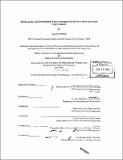| dc.contributor.advisor | R. John Hansman and Thomas Kochan. | en_US |
| dc.contributor.author | Miller, Jared Keith, 1977- | en_US |
| dc.contributor.other | Leaders for Manufacturing Program. | en_US |
| dc.date.accessioned | 2007-04-03T17:05:24Z | |
| dc.date.available | 2007-04-03T17:05:24Z | |
| dc.date.copyright | 2003 | en_US |
| dc.date.issued | 2003 | en_US |
| dc.identifier.uri | http://hdl.handle.net/1721.1/37047 | |
| dc.description | Thesis (S.M.)--Massachusetts Institute of Technology, Dept. of Civil and Environmental Engineering; and, (S.M.)--Massachusetts Institute of Technology, Sloan School of Management; in conjunction with the Leaders for Manufacturing Program at MIT, 2003. | en_US |
| dc.description | Includes bibliographical references (leaf [109]). | en_US |
| dc.description.abstract | The tragic events of September 11th , 2001, served as a catalyst for drastic change in the airline industry which was already in a financial downturn. Both the airlines and the government began introducing changes to the various aspects of the travel experience. The most impactful changes have been in the area of security, where an entirely new government agency has been created to oversee security at airports. However, additional changes to the travel experience have come from the airlines. This research provides an overview and analysis of one such change that is sweeping the industry. Self-service check-in devices were first installed by major network airlines in 1995 when Continental Airlines introduced the ETICKET machine. Others have since developed their own self-service products, while Continental has transformed its original machine into the eService product line. These devices empower the traveling customer to perform their own check-in and get through the airport quicker. Additionally, self-service check-in devices represent a cost savings opportunity for the airlines through reduced headcount requirements and ticket distribution fees. While deployment has been rapid both at Continental and other airlines, the development of a process that merges the ticket agents with the new technology has been lacking. In 2002, Continental Airlines began a cross-functional effort to drastically re-engineer the selfservice process. Many of the traits of that process have been implemented to some extent throughout Continental's domestic airports. Through observations of the current self-service process, surveys of both ticket agents and customers, and an in-depth case study comparison of two airports, this research has identified numerous opportunities for improvement of the process. In addition, the research provides recommendations for the next phases of the re-engineering process based on the findings of the observations and surveys. Finally, areas for future research that build off of these findings are presented with the goal of improving the travel experience for the customers and reducing costs for the airlines. | en_US |
| dc.description.statementofresponsibility | by Jared Keith Miller. | en_US |
| dc.format.extent | 108, [1] leaves | en_US |
| dc.language.iso | eng | en_US |
| dc.publisher | Massachusetts Institute of Technology | en_US |
| dc.rights | M.I.T. theses are protected by copyright. They may be viewed from this source for any purpose, but reproduction or distribution in any format is prohibited without written permission. See provided URL for inquiries about permission. | en_US |
| dc.rights.uri | http://dspace.mit.edu/handle/1721.1/7582 | |
| dc.subject | Civil and Environmental Engineering. | en_US |
| dc.subject | Sloan School of Management. | en_US |
| dc.subject | Leaders for Manufacturing Program. | en_US |
| dc.title | Reducing the air travel hassle factor through self-service check-in process improvements | en_US |
| dc.type | Thesis | en_US |
| dc.description.degree | S.M. | en_US |
| dc.contributor.department | Leaders for Manufacturing Program at MIT | en_US |
| dc.contributor.department | Massachusetts Institute of Technology. Department of Civil and Environmental Engineering | |
| dc.contributor.department | Sloan School of Management | |
| dc.identifier.oclc | 52753149 | en_US |
